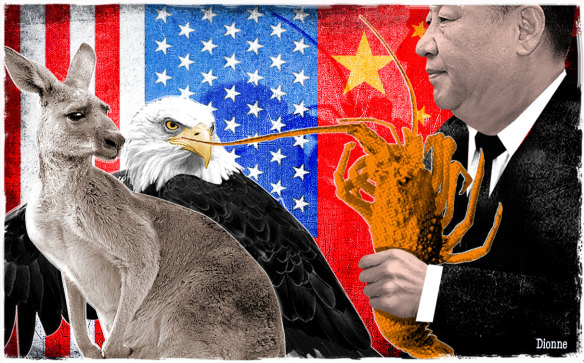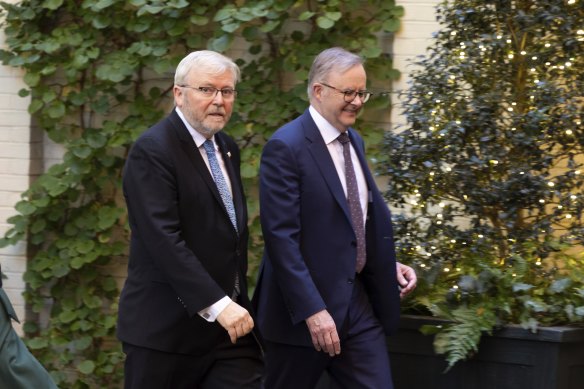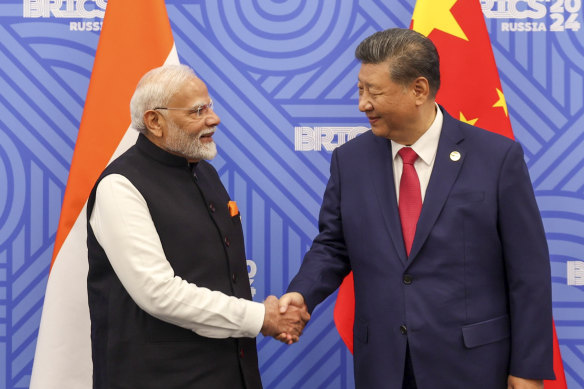This was published 4 months ago
Opinion
Xi’s grandiose plan for the Asia-Pacific is not working. Kevin Rudd knows why
Peter Hartcher
Political and international editorPressure and release. That’s China’s formula for dealing with Australia, and a range of other nations, according to Kevin Rudd, one of the West’s foremost experts on the ideology and strategy of President Xi Jinping.
Beijing’s strategy is unchanging and unrelenting. However: “What is under continual re-evaluation is tactics. Tactics alternate between pressure and release, depending on other developments and the state of the bilateral relationship,” Rudd tells me.

Illustration by Dionne Gain
This makes sense of moves that otherwise seem contradictory. Why, for instance, did Xi’s government last week agree to a settlement with India over a hotly contested border dispute, yet antagonise Indonesia by intruding into its territorial waters at the same time?
Because Xi decided it was time to release China’s four-year-long pressure on India, while applying pressure afresh on Indonesia. It was, after all, a special day for Indonesia. It was the first day in office for its new president, Prabowo Subianto, and the perfect time to test him.
But what about China’s current treatment of Australia? It appears baffling.

Fremantle fisherman Fedele Camarda celebrates the end of Chinese trade sanctions on Australian lobsters.Credit: Ross Swanborough
On one hand, Xi has ended the freeze on political contact with Australia and lifted his punitive ban on $20 billion in Australia’s annual exports. On the other, China’s military continues to harass Australian defence forces in international seas and skies.
Just this month, Beijing removed the final trade barrier – allowing exports of Australian lobsters – yet last week launched a blistering diplomatic assault on Australia in the United Nations, accusing it of telling “lies to create confrontation”.
So is Australia in the “pressure” phase of Xi’s tactical binary or the “release” phase? Says Rudd: “We are in a period of both.” If we find that confusing or unsettling, then perhaps we’re supposed to.
“There will be tactical moves, whether about lobsters or robust resolutions under the UN over human rights” but the strategy is constant. So what is the strategy? What’s the point of it all? “The underpinning strategy,” says Rudd, “is constantly seeking to separate the US from its allies.”
Xi, through a combination of rewards and punishments, carrots and sticks, seeks to recondition Australian policy and conduct. We are supposed to see that the United States can’t protect us from Beijing’s moods, and instead devote our energies to anticipating China’s wishes and act accordingly.

Australian ambassador to the US Kevin Rudd and Prime Minister Anthony Albanese in Washington last October.Credit: Alex Ellinghausen
“To whatever extent China seeks to stabilise with the US and seeks to challenge US allies, China’s overall strategy is to force allied governments – whether it’s Australia, New Zealand, Canada, South Korea or Japan – to conclude they should consider other options” than their alliances with the US.
In other words, the dangerous and unprofessional People’s Liberation Army provocations of the Australian Defence Force in international seas and skies will continue. Beijing might deign to accept Australian lobster but will not recognise Australia’s long-standing freedoms of navigation and overflight, even in international spaces.
“China’s attitude to Australia and Canada and other US allies in disputed zones” – meaning the international waters and skies around the South China Sea, the East China Sea and Taiwan – “continues to be assertive, continues to be aggressive, and therefore problematic, not just for Australia but for other allies.”
This doesn’t fit readily with the Albanese government’s theme of a “stabilisation” of the relationship. Xi didn’t get the talking points from Canberra, it seems.

India’s Prime Minister Narendra Modi greets Chinese President Xi Jinping at the BRICS Summit in Russia last week.Credit: AP
Rudd is speaking to me on the publication of his new book, On Xi Jinping, an adaptation of his 2022 Oxford doctorate. He emphasises that he’s speaking as a Sinologist of 40 years’ standing and not as an Australian diplomat. American China expert Jude Blanchette says the book “will set the bar for future studies of Xi’s governing philosophy”.
Rudd says we shouldn’t be surprised or confused by the tactics of “pressure and release”, whether they’re applied alternately or simultaneously. “We sometimes think we are Robinson Crusoe in this; we are not. A whole bunch of other countries are going through exactly the same experience.”
“So we shouldn’t see it as remarkable. It’s part of a strategic constant, as opposed to waking up in the morning with shock and horror.”
US allies are one category; countries in territorial dispute with China are another. There are 16 of them including Japan, South Korea, India, Vietnam, Malaysia, the Philippines and Indonesia. In dealing with these nations, “Xi’s overall position is no compromise,” says Rudd, “with tactical flexibility, depending on whether China decides it’s necessary according to the bilateral relationships.”
How effective is Xi’s combination of strategies and tactics? It’s effective in antagonising and annoying other nations. But it’s not achieving its goals, says the former Australian prime minister. “China’s strategy is not working.”
No US ally has abandoned its alliance under pressure from Beijing. On the contrary, Australia, Japan and South Korea have strengthened their US alliances. Among countries in territorial dispute with China, Beijing had some earlier success in cowing the Philippines’ former president, Rodrigo Duterte, into submission but under current president Bongbong Marcos, it is putting up a spirited resistance.
And what of Xi’s economic strategy? Is he succeeding in pulling the country out of its four-year go-slow? The world’s investors watch Beijing in breathless anticipation every time its officials step up to announce extra stimulus, only to suffer an anticlimax. Every time.
Xi very deliberately has pursued a policy that is “more statist, more interventionist, more Marxist”, says Rudd, to “make sure the party-state is not challenged” by the private sector and an increasingly confident capitalist class.
As a result, “Chinese private sector confidence has been declining and you see that in declining fixed capital investment, declining consumer confidence, that’s a huge driving factor. As a result of that, you see an emerging growth deficit.”
Xi has the option of a dramatic change in approach, empowering the private sector once more, “but he’s not done that – he’s employed temporary monetary and fiscal stimulus to cover the growth gap,” Rudd explains. Xi is deliberately keeping China’s private sector under pressure, with no release.
Pressure and release is the dynamic of the volcano. We should expect more volatility ahead.
Peter Hartcher is international editor.
The Opinion newsletter is a weekly wrap of views that will challenge, champion and inform your own. Sign up here.